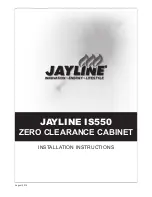
10
CHIMNEY
The stove must not be connected to any other distribution system: such as an incinerator, heating system or ventilation
system.
The Diamond requires a stainless liner that must be placed from the nozzle of the stove to the top of the chimney.
The liner facilitates the sweeping and maintenance, since the sweeping can be done from the top of the chimney and that
the deposits can be removed from inside the insert.
Before connecting the unit, the chimney must be swept thoroughly to make sure there are no deposits. All materials used
for connecting the stove must be resistant to corrosion.
MINIMUM HEIGHT OF THE CHIMNEY
The chimney must extend at least
3' (915 mm)
past its point of
contact with the roof and must be at least
2' (610 mm)
any walls,
roof or building in a radius of
10' (3050 mm).
If the chimney
exceeds the roof by
5' (1525 mm)
or more, it must have a
chimney brace.
VENTILATION
Venting Requirements:
The flue is a critical component to a satisfactory installation. Your Diamond Insert will attain its best performance if
installed with a chimney that generates its own draft. The minimum requirement of a flue will be the installation of a flue
connector (the liner must conform to
UL1777
chimney liners) from the insert into the first flue tile of the chimney (USA),
or a continuous stainless steel liner (the liner must conform to the Class 3 requirements of
CAN/ULC-S635
) directly
connected to the flue outlet (Canada). A continuous 6’’ (152mm) stainless steel liner from the top of the chimney is the
optimum system and will provide the best performance, as well as compensate for poor draft situations.



































